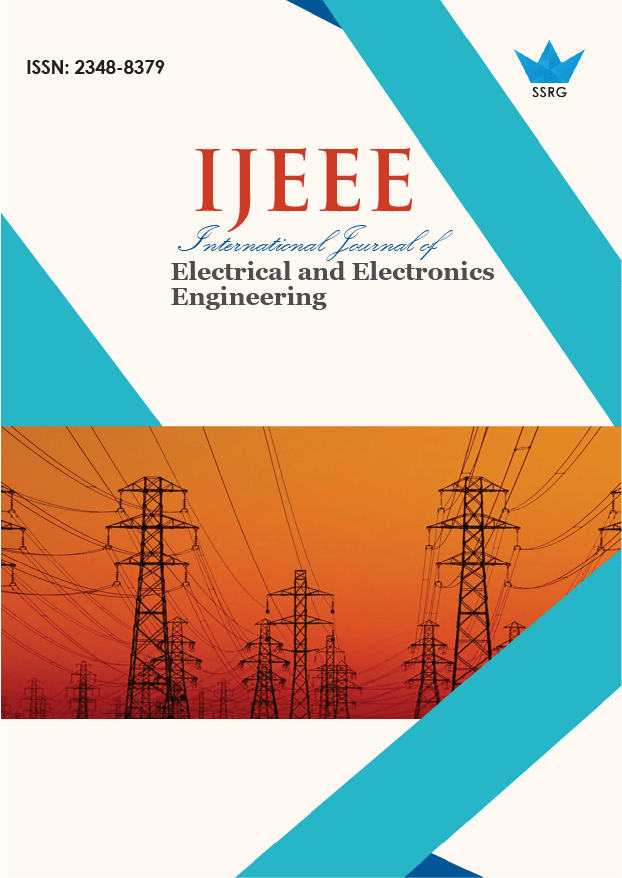Infinite Simple Cubic Network of Identical Capacitor: Analysis of Perfect and Perturbed Cases

| International Journal of Electrical and Electronics Engineering |
| © 2025 by SSRG - IJEEE Journal |
| Volume 12 Issue 6 |
| Year of Publication : 2025 |
| Authors : Ataa Hikmat Almallak, Rabab Jarrar, Jihad Asad |
How to Cite?
Ataa Hikmat Almallak, Rabab Jarrar, Jihad Asad, "Infinite Simple Cubic Network of Identical Capacitor: Analysis of Perfect and Perturbed Cases," SSRG International Journal of Electrical and Electronics Engineering, vol. 12, no. 6, pp. 1-13, 2025. Crossref, https://doi.org/10.14445/23488379/IJEEE-V12I6P101
Abstract:
Using the Lattice Green Function (LGF), the effective capacitance of an infinite SC network (made of identical capacitors) between the origin site and another site inside the network was computed in this study. Two situations were considered: the disturbed case of the infinite network, whereby one capacitance was eliminated between two sites, and the ideal instance of an infinite SC network. This study derives the general formula linking the capacitance of an endless network using the Lattice Green Function (LGF) for both circumstances (ideal and disturbed). Based on the (LGF) at the origin, the capacitance of the infinite SC network is stated in relative terms.
Keywords:
Lattice Green Function, Infinite network, Capacitors, Perfect case, Perturbed case.
References:
[1] Peter G. Doyle, and J. Laurie Snell, Random Walk and Electrical Networks, The Carus Mathematical Monograph, The Mathematical Association of America, vol. 22, 1984.
[Google Scholar] [Publisher Link]
[2] D. Atkinson, and F.J. Van Steenwijk, “Infinite Resistance Lattices,” American Journal of Physics, vol. 67, pp. 486-492, 1999.
[CrossRef] [Google Scholar] [Publisher Link]
[3] G. Rickayzen, Green’s Functions and Condensed Matter, Dover Publications, Academic Press, London, 1980.
[Google Scholar] [Publisher Link]
[4] Giulio Venezian, “On the Resistance Between Two Points on a Grid,” American Journal of Physics, vol. 62, no. 11, pp. 1000-1004, 1994.
[CrossRef] [Google Scholar] [Publisher Link]
[5] József Cserti, “Application of the Lattice Green’s Function: Resistance of an Infinite Network of Resistors,” American Journal of Physics, vol. 68, no. 10, pp. 896-906, 2000.
[CrossRef] [Google Scholar] [Publisher Link]
[6] József Cserti, Gyula Dávid, and Attila Piróth, “Perturbation of Infinite Networks of Resistance,” American Journal of Physics, vol. 70, no. 2, pp. 153-159, 2002.
[CrossRef] [Google Scholar] [Publisher Link]
[7] J. Cserti, G. Széchenyi, and G. Dávid, “Uniform Tiling with Electrical Resistors,” Journal of Physics A: Mathematical and Theoretical, vol. 44, no. 21, 2011.
[CrossRef] [Google Scholar] [Publisher Link]
[8] M. Owaidat, “On the Uniform Tiling with Electrical Resistors,” arXiv preprint, 2013.
[CrossRef] [Google Scholar] [Publisher Link]
[9] R.J. Duffin, and E.B. Shelly, “Difference Equation of Poly-Harmonic Type,” Duke Mathematical Journal, vol. 25, no. 2, pp. 209-238, 1958.
[CrossRef] [Google Scholar] [Publisher Link]
[10] Tsuyoshi Horiguchi, “Lattice Green’s Function for the Simple Cubic Lattice,” Journal of the Physical Society of Japan, vol. 30, no. 5, pp. 1261-1271, 1971.
[CrossRef] [Google Scholar] [Publisher Link]
[11] George N. Watson, “Three Triple Integrals,” The Quarterly Journal of Mathematics, vol. os-10, no. 1, pp. 266-276, 1939.
[CrossRef] [Google Scholar] [Publisher Link]
[12] Eleftherios N. Economou, Green’s Functions in Quantum Physics, 2nd ed., Springer-Verlag, Berlin, 1983.
[CrossRef] [Google Scholar] [Publisher Link]
[13] Robert B. Laughlin, “Anomalous Quantum Hall Effect: An Incompressible Quantum Fluid with Fractionally Charged Excitations,” Physical Review Letters, vol. 44, pp. 225-236, 2005.
[CrossRef] [Google Scholar] [Publisher Link]
[14] G.S. Joyce, “Lattice Green Function for the Simple Cubic Lattice,” Journal of Physics A: General Physics, vol. 5, no. 8, 1972.
[CrossRef] [Google Scholar] [Publisher Link]
[15] Sayak Bhattacharjee, and Kabir Ramola, “Green's Functions for Random Resistor Networks,” Physical Review E, vol. 108, no. 4, 2023.
[CrossRef] [Google Scholar] [Publisher Link]
[16] Joseph A. Yasi, and Dallas R. Trinkle, “Direct Calculation of the Lattice Green Function with Arbitrary Interactions for General Crystals,” Physical Review E-Statistical, Nonlinear, and Soft Matter Physics, vol. 85, no. 6, 2012.
[CrossRef] [Google Scholar] [Publisher Link]
[17] M.L. Glasser, and J. Boersma, “Exact Values for Cubic Lattice Green Functions,” Journal of Physics A: Mathematical and General, vol. 33, no. 28, pp. 5017-5023, 2000.
[CrossRef] [Google Scholar] [Publisher Link]
[18] Xinsheng Wang et al., “On Model Order Reduction of Interconnect Circuit Network: A Fast and Accurate Method,” Mathematics, vol. 9, no. 11, pp. 1-13, 2021.
[CrossRef] [Google Scholar] [Publisher Link]
[19] Bingnan Wang, Jiang Long, Koon Hoo Teo, “Multi-Channel Capacitive Sensor Arrays,” Sensors, vol. 16, no. 2, pp. 1-12, 2016.
[CrossRef] [Google Scholar] [Publisher Link]
[20] Scott Kirkpatrick, “Percolation and Conduction,” Reviews of Modern Physics, vol. 45, no. 4, pp. 574-588, 1973.
[CrossRef] [Google Scholar] [Publisher Link]
[21] Michael D. Bartlett, Michael D. Dickey, Carmel Majidi, “Self-Healing Materials for Soft-Matter Machines and Electronics,” NPG Asia Materials, vol. 11, no. 1, pp. 1-4, 2019.
[CrossRef] [Google Scholar] [Publisher Link]
[22] Jiong Pan et al., “Principles and Applications of Two-Dimensional Semiconductor Material Devices for Reconfigurable Electronics,” Nanomaterials, vol. 15, no. 3, pp. 1-21, 2025.
[CrossRef] [Google Scholar] [Publisher Link]
[23] Jaemin Kim et al., “Stretchable Silicon Nanoribbon Electronics for Skin Prosthesis,” Nature Communications, vol. 5, no. 1, pp. 1-11, 2014.
[CrossRef] [Google Scholar] [Publisher Link]
[24] Cun Zhao et al., “Stress Wave Propagation and Energy Absorption Properties of Heterogeneous Lattice Materials Under Impact Load,” Advances in Materials Science and Engineering, vol. 2021, no. 1, pp. 1-14, 2021.
[CrossRef] [Google Scholar] [Publisher Link]
[25] Xuelong Wang et al., “Microstructured Flexible Capacitive Sensor with High Sensitivity based on Carbon Fiber-Filled Conductive Silicon Rubber,” Sensors and Actuators A: Physical, vol. 312, 2020.
[CrossRef] [Google Scholar] [Publisher Link]
[26] Sheng Xu et al., “Soft Microfluidic Assemblies of Sensors, Circuits, and Radios for the Skin,” Science, vol. 344, no. 6179, pp. 70-74, 2014.
[CrossRef] [Google Scholar] [Publisher Link]
[27] Martin Hÿtch et al., “Nano-Scale Holographic Interferometry for Strain Measurements in Electronic Devices,” Nature, vol. 453, no. 7198, pp. 1086-1089, 2008.
[CrossRef] [Google Scholar] [Publisher Link]

 10.14445/23488379/IJEEE-V12I6P101
10.14445/23488379/IJEEE-V12I6P101